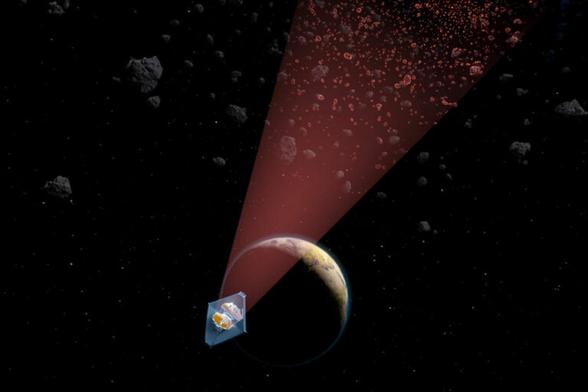#trump #putin #meeting #saudiarabia #asteroid #nearearthasteroid #politics
If only it could target the meeting of Trump and Putin in Saudi Arabia.
https://news.sky.com/story/odds-of-asteroid-hitting-earth-rise-again-13312577
#NearEarthAsteroid
#2024YR4 #asteroid #space #nasa #esa #astronomy #nearearthasteroid #earth
What a great story to wake up to. Trump’s also threatening Russia with military action if they don’t agree to a Ukraine peace deal.
Happy Friday everyone!
https://news.sky.com/story/a-serious-threat-to-earth-what-we-know-about-asteroid-on-possible-collision-course-13307919
Webb ontdekt 138 decameter asteroïden in de hoofdgordel
Deze asteroïden zijn slechts 10 meter in doorsnede en zijn daarmee de kleinste asteroïden die ooit in de asteroïdengordel zijn waargenomen.
Een artist impressie van Webb die in het infrarood een populatie van decameter-asteroïden in de hoofdgordel laat
https://www.kuuke.nl/webb-ontdekt-138-decameter-asteroiden-in-de-hoofdgordel/
#asterode #asterodengordel #decameter #hoofdgordel #infrarood #NearEarthAsteroid #NEO #webb
An Asteroid Found Sharing the Orbit of Mars
https://www.universetoday.com/166266/an-asteroid-found-sharing-the-orbit-of-mars/ #astronomy #Asteroids #Mars #SolarSystem #capturedobjects #Mars Trojans #NearEarthAsteroid #TadpoleOrbit #TrojanAsteroids #trojanorbit
Planetary Defence: DART Impact Changed both Orbit and Shape of asteroid
In the last 500 million years, there have been at least five episodes of mass extinctions of life-forms on the Earth when more than three-quarters of...........
#Asteroid #DARTmission #NASA #nearEarthasteroid #NEO #Planetarydefence
SCIEU Team
Fragments From That Asteroid That Exploded Above Berlin Have Been Recovered and They're Really Special https://www.universetoday.com/165625/fragments-from-that-asteroid-that-exploded-above-berlin-have-been-recovered-and-theyre-really-special/ #chelyabinskmeteorite #meteoriticalsociety #nearearthasteroid #apolloasteroids #setiinstitute #asteroids #aubrites #featured #2024bx1 #meteors
near-Earth asteroid 2024 BJ to make closest approach to Earth
On 27 January 2024, an airplane-sized, near-Earth asteroid 2024 BJ will pass Earth at a closest distance of 354,000 Km.
It...........
#2024BJ #Asteroid #nearEarthasteroid
SCIEU Team
What #astronomers learned from a near-Earth asteroid they never saw coming
No one spotted space rock 2023 NT1 until two days after it missed us.
By Briley Lewis | Published Nov 1, 2023
"In the summer, astronomers spotted an airplane-sized asteroid—large enough to potentially destroy a city—on an almost-collision course with Earth. But no one saw the space rock until two days after it had zoomed past our planet.
"This asteroid, named 2023 NT1, passed by us at only one-fourth of the distance from Earth to the moon. That’s far too close for comfort. Astronomers weren’t going to let this incident go without a post-mortem. They’ve recently dissected what went wrong and how we can better prepare to defend our planet from future impacts, in a new paper recently posted to the preprint server arXiv.
"We know from history that asteroids can cause world-shattering events and extinctions—just look at what happened to the dinosaurs. The study team estimated that, if NT1 hit Earth, it could have the energy of anywhere from 4 to 80 intercontinental ballistic missiles. '2023 NT1 would have been much worse than the Chelyabinsk airburst,' says University of California, Santa Barbara astronomer Philip Lubin, a co-author on the new work, referring to the meteor that exploded over a Russian city in 2013. As devastating as that would be, it’s 'not an existential threat like the 10-kilometer hit that killed our previous tenants,' he adds.
"The asteroid-monitoring system ATLAS, the 'Asteroid Terrestrial-impact Last Alert System”—four telescopes in Hawaii, Chile, and South Africa—discovered NT1 after the rock flew by. ATLAS’s entire purpose is to scour the skies for space rocks that might threaten Earth. So with this set of eyes on the sky, how did we miss it?
"It turns out that Earth has what Brin Bailey, UC Santa Barbara astronomer and lead author on the paper, calls a “blindspot.” Any asteroid coming from the direction of the sun gets lost in the glare of our nearest star.” There’s another way for asteroids to sneak up on us, too: the smaller the asteroid, the harder it is for our telescopes to spot them, even when the rocks come from parts in the sky away from the sun.
“'Currently, there is no planetary defense system which can mitigate short-warning threats,' Bailey says. 'While NT1 has no chance of intercepting Earth in the future, it serves as a reminder that we do not have complete situational awareness of all potential threats in the solar system,” they add. That leads to Lesson #1: We simply need better detection methods for planetary defense."
Read more:
https://www.popsci.com/science/asteroid-nt1-earth-planetary-defense/?utm_source=pocket-newtab-en-us
NASA’s OSIRIS-REx Mission brings sample from asteroid Bennu to Earth
NASA’s first asteroid sample return mission, OSIRIS-REx, launched seven years ago in 2016 to near-Earth asteroid Bennu has delivered the asteroid...........
#Apophis #Asteroid #asteroidsamplereturn #Bennu #NASA #nearEarthasteroid #originoflife #OSIRISAPEX #OSIRISREx
Umesh Prasad
[everybody wave ]
#nearEarthAsteroid #asteroid
[previously i tagged such things as 'space friend' and 'good rock'. because accuracy is difficult for me and emotion is easy ]
